Japanese Design Archive Survey
DESIGN ARCHIVE
Designers & Creators
Fujiwo Ishimoto
Textile designer, Ceramic artist
Date: 21 September 2023, 14:30-16:00
Method of interview: Online
Interviewees: Fujiwo Ishimoto
Interviewers: Yasuko Seki, Aia Urakawa
Writing: Aia Urakawa
PROFILE
Profile
Fujiwo Ishimoto
Textile designer, Ceramic artist
1941 Born in Tobe, Ehime
1960 Entered the Department of Crafts, Faculty of Fine Arts, Tokyo University of the Arts, majoring in graphic design
1964 Joins textile trading company ICHIDA
1970 After leaving ICHIDA, embarked on a world tour
Joins Decembre, an affiliate of Marimekko in Finland
1974 Joins Marimekko in Finland and is employed as a designer
1989 Begins making ceramics as a visiting artist in the art department of ARABIA
1994 Kaj Franck Design Prize
1997 Awarded the City of Helsinki Culture Prize
2006 Retires from Marimekko
2010 Pro Finlandia Medals of the Order of the Lion of Finland
2011 The Order of the Rising Sun, Gold Rays with Rosette
2020 Return to Japan
2022 Establishes a studio in Dogo, Matsuyama, Ehime
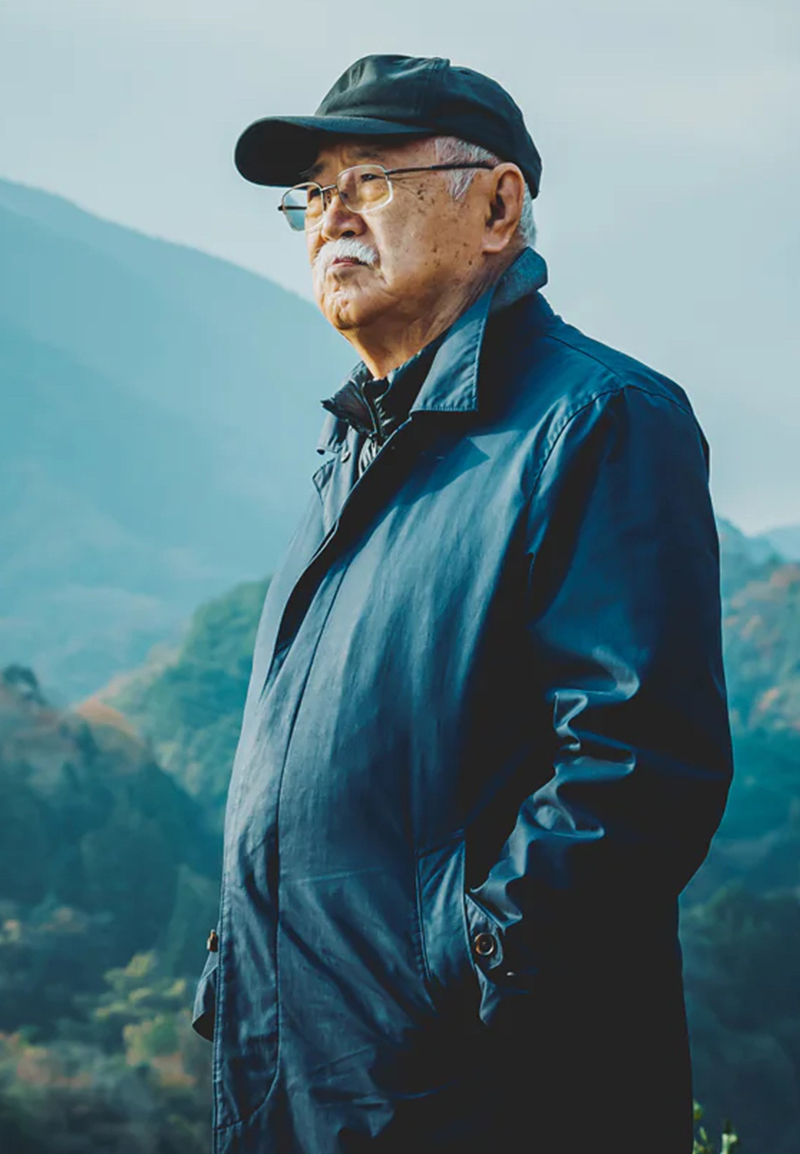
Description
概要
From the 1960s to the 1970s, many Japanese designers spread their wings and expanded their activities around the world. Among these, Fujiwo Ishimoto's interest was drawn to Marimekko, a Finnish textile manufacturer with many fans around the world. He continued to submit design proposals to Marimekko every year while working for the Finnish affiliate, and for the third time got the chance to be adopted. He then worked for the Marimekko for 32 years from 1974. During that time, he designed more than 400 textiles, making him the second most successful designer in the company's history. While working for Marimekko, he also began making ceramics for the art department of the Finnish ceramics brand ARABIA in 1989. In 1994, he was awarded the Kaj Franck Design Prize for Finnish designers in recognition of the variety of works he has produced to enrich people's lives, and in 2010 he was awarded the Pro Finlandia Medals of the Order of the Lion of Finland In 2011. It has made a name for itself around the world.
The world Ishimoto creates is based on Finland, a country of forests and lakes, and the natural landscape he became familiar with as a child in his birthplace of Tobe, Ehime Prefecture. The landscapes are not special, but rather commonplace and nostalgic. Ishimoto's unique sensibility, powers of observation and sense of colour enable him to find radiant beauty in the most trivial of everyday situations. Marimekko's textile works have a charm that stimulates the senses, with colours that enrich the mind like music, the sound of grass and trees rustling in the wind, and the scent of sweet flowers wafting through the air. The subjects of the ceramic artworks included tsukushi, fuki(butterbur) and ooinufuguri(Persian speedwell), which grow on roadsides and in fields. And he often uses fruits as motifs, as his family in Ehime Prefecture were mandarin orange farmers, and the energy of life can be felt in the rounded, fruit-filled forms of his works.
After leaving Marimekko in 2006, Ishimoto concentrated on his ceramic art, returning to Japan in 2020 and setting up a studio in Dogo, Ehime in 2022, where he continues to work energetically. Ishimoto's Marimekko textiles are still being revived and developed into a variety of products and spaces, and he has also created tenugui and other products based on ideas that were not commercialised at the time. How do you organise and store sketches and materials from the Marimekko and ARABIA periods and the present, which are also important elements in the development of revival products such as these? We asked him about it while looking back on his footsteps to date.
Masterpiece
Masterpiece
Marimekko textiles
"Onni (Happiness) " (1975); '"Kukkaketo (Flower Garden) " (1975); "Kuja (Alley) " (1976); "Sumo" (1977); "Jama (Mountain) " (1977); "Suvi (Summer) " (1977); "Taiga (Meadow) " (1978); "Kuuma (Heat)" (1978); "Seven Flowers" (1978); "Sarastus (Dawn) " (1980); "Kuiskaus (Whispers) " (1981); "Nauru (Laughter) " (1982); "Ilo (Joy) " (1981); "Maisema (Landscape) " (1982); "Linnunpesä (Bird's Nest) " (1982); "Ostjaki (Taken from a Finn name) " (1983); "Lompolo (A small lake in Lapland) " (1983); "Isokarhu (The Big Dipper) " (1983); "Sinitaivas (Blue Spreads)" (1985); "Koski (Stream) " (1986); "Kesanto (Fallow Land) " (1988); "Salava (A kind of willow) " (1988); "Lainehtiva (Swell)'" (1988); "Korsi (Straw) " (1989); "Linnanpuisto (The Castle Garden) " (1989); "Lepo (Rest) " (1991); "Kesästä kesään (From Summer to Summer) " (1991); "Suuri Taiga (Prairie) " (1992); "Ukonhattu (Torikabuto) " (1993); "Sudenmarja (Wolfberry) " 1993); "Siimes (Shade) " (1995); "Ruusumaja (House of Roses) " (1995); "Paratiisi (Paradise) " (1996); "Lehmus (Bodhi Tree) " (1997); "Vire (Fluttering Banner) " (1997); "uhla (Feast Day, Festival) " (1998); "Lähde (Fountain) " (1999); "Hurmio (Enthralled) " (1999); "Neidonkorento (Dragonfly) " (2002); "Villi ja vapaa (Tomboy) " (2003); "Selänne (Distant view from the water) " (2003); "Tuulispää (A puff of wind) " (2004)
Ceramic works (including works made in Arabia)
"Yama', 'Kabocha; "Akai mi"; "Ooinufuguri"; "Mikan"; "Yamamomo"; "Uri"; "Shirouri"; "Tougan"; "Nanten"; "Stripe"; "Ume"; "Hechima"; "Aoi mi"; "Umi"; "Budou"; "Hana"; "Kouhakubana"; "Yanagi"; "Olibu"; "Tou no hana"; "Enban"; "Tsubomi"
Mustakivi products
MUKI mugs, TUULI cups, KASANE cups, KASANE plates, PIKKU small plates, SOBA plates, SOBA ladle rests, HORISONTTI plates, LONG PLATE long square plates, MIZUHIKI plates, ONNEA goblets, ONNEA bowls, ONNEA large bowls, CUP, PLATE round plates, PLATE square plates, NASSEN tenugui, CHUSEN tenugui, CHUSEN hankachi, IROHA face towel, KUKKIA broach, FUJIWO ISHIMOTO framed posters, FUJIWO ISHIMOTO postcards, PLEATS flowerbase
Books
"Fujiwo Ishimoto: Matkalla Resan On the Road"(Marimekko Oyj、2002); "Ishimoto Fujiwo no nuno to tou" (PIE International, 2012)
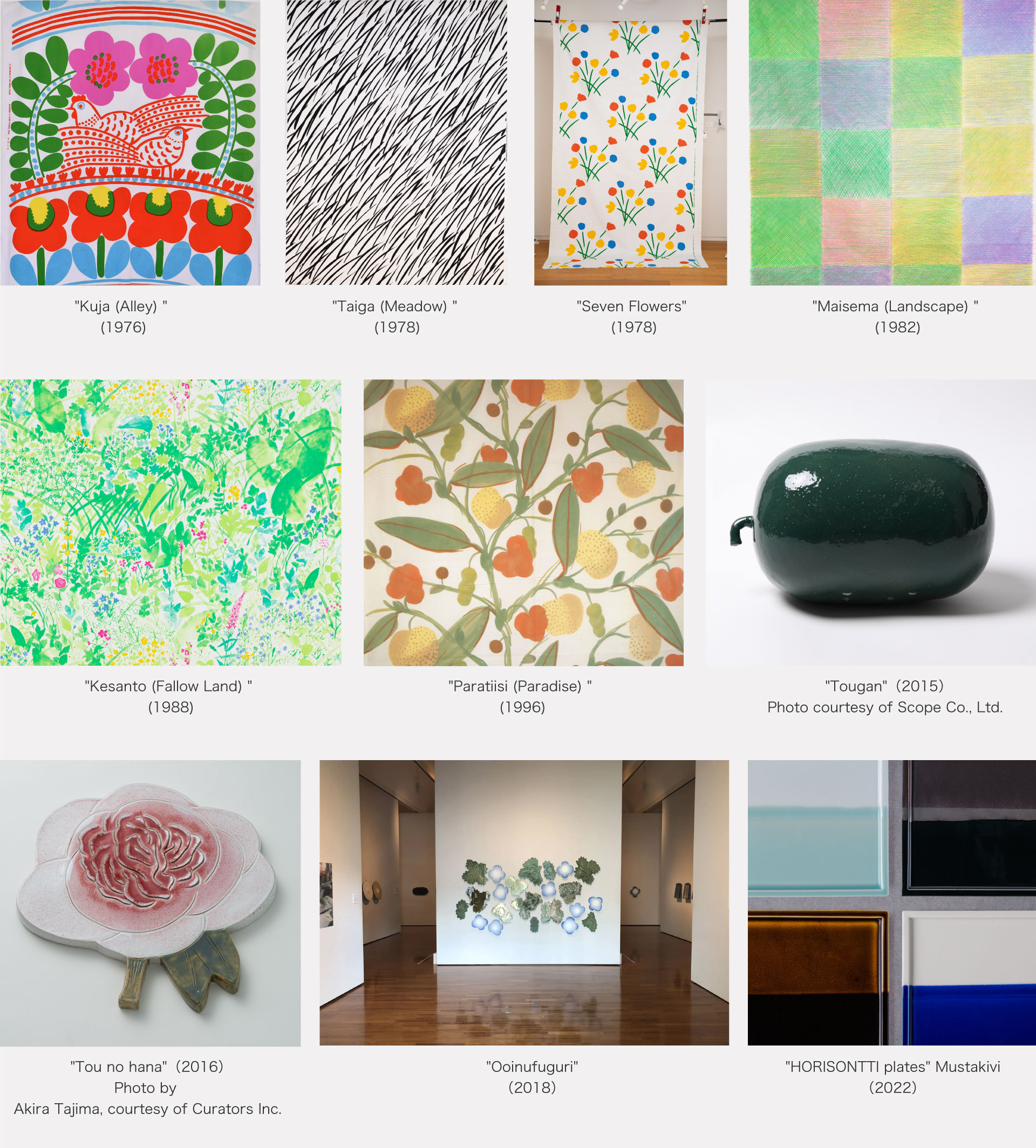
Interview
Interview
I do not organise my sketches and documents. It is the weakest part of me. I consider it hard work
Exposure to ceramics during university and encounter with Marimekko
ー I was told by Mr. Motomi Kawakami in a previous interview for this PLAT design archive that there were a variety of designers who were classmates at Tokyo University of the Arts. I heard that Mr. Shin Matsunaga, Mr. Takahisa Kamijo and Mr. Ishimoto were there. So I was very interested in talking to you about your work and archive materials, I contacted you.
Ishimoto There were many other people who were classmates at the Tokyo University of the Arts. Among picture book authors, there was Ms. Kayako Nishimaki, who drew "Watashi no Wanpisu" (KOGUMA Publishing, 1969), and Mr. Kazuo Iwamura, who worked on the "14 hiki sirizu" (DOSHINSHA PUBLISHING, 1983-). I think you have probably seen them before. Tokyo University of the Arts had until then been known as Zuan-ka, which taught graphic and product design, but I was lucky. I entered the university in 1960, and in my generation the number of students was increased from 25 to 70, and the department was changed to the Crafts Department, which combined design and crafts. The first and second years were spent learning the basics, and in the first semester of the third year, students were taught metalwork (engraving, forging and casting), lacquer, ceramics, dyeing and weaving, woodwork, graphic and product design for three weeks each. Some of the teachers were living national treasure artists, and in the fourth year we had to choose our course of study based on which direction we wanted to go in for the future, and most of us chose crafts and went on to postgraduate studies. One year is not enough time to learn the craft. I chose graphic design. I think most of the people who chose graphic or product design got a job.
ー Aside from graphics, were there any other classes that interested you?
Ishimoto I was very interested in ceramics, and it was interesting to actually try it. But going into ceramics felt like going back to my hometown in Ehime. In short, I wanted to go to Tokyo anyway, so I applied to a university in Tokyo. I didn't want to go back to my hometown. But I am very glad that I was able to experience ceramics. In the pottery class, I used a potter's wheel for the first time, and we had to make a 30 cm high vase, and I thought I would make a vase with Tsukushi as a motif. Do you know what a hakama is? I drew lines on the hakama by scratching it with a knife in a mountainous shape, a technique I have also used in my recent works. I thought I did a good job with that piece and I liked it, but I had to leave it at the university. I then contacted the university to see if it was still there, and was disappointed to find that it had been lost.
ー You first became aware of Marimekko when you were at university. What attracted you to Marimekko amongst all the other textile brands?
Ishimoto When I was in my third year of university, I first saw Marimekko textiles in the Swedish design magazine "FORM" and in a German interior design magazine. Until then, most textile designs had been traditional small floral patterns, but designer Ms. Maija Isola's boldly drawn poppy flower motifs, such as "Unikko (Poppy Flower) ", were unprecedented and very exciting in their novelty, like modern art. I was particularly interested in the textile "FANDANGO (Dance, Music) ", which Ms. Maija created inspired by folk costumes. I wanted to work for Marimekko, but a senior student at Tokyo University of the Arts joked that Marimekko would only accept women, which I believed and was discouraged at the time.
ー Many people who majoured in graphic design at the Tokyo University of the Arts, such as Mr. Masayoshi Nakajo of a slightly older generation, went on to work for Shiseido Company.
Ishimoto Ms. Eiko Ishioka also joined Shiseido Company. When I was thinking about where to work, I was most interested in Shiseido Company. When I asked Ms. Ishioka to look at the work I had made at Tokyo University of the Arts, she said, "You are better at ICHIDA than Shiseido Company, you should go to ICHIDA". ICHIDA is the top trading company in the textile industry, and Ms. Ishioka was interested in that company. In fact, the chief professor at the Tokyo University of the Arts also saw what I was making in the dyeing and weaving class and said that a textile company would suit my personality. With their advice, I joined the ICHIDA and went into textile, which I think was very good for my life afterwards.
At ICHIDA, I was put in charge of drapery immediately after joining the company. As a newcomer, you are sent to a department where not many people want to work. I didn't know anything about kimonos until then, but when I saw a komon pattern for the first time, I was surprised and impressed by the beauty of the precisely drawn fine lines. I then studied various things, such as the unique Japanese sense of beauty, how to create harmony, and the beauty of contrast by combining different things rather than collecting only similar things, and I became deeply involved in the world of kimonos. As well as designing the kimonos themselves, I was also involved in graphic and art direction work, such as learning how to dress people, dressing models in kimonos for photo shoots and creating PR magazines.
It was around that time that I saw Marimekko textiles in the flesh. The manager of the Marimekko shop in Helsinki, Finland, was visiting a friend of mine and showed me many textiles that she had brought there. Most of them were large abstract designs by Ms. Maija.
ー I think ICHIDA sounds very interesting, but why did you leave the company in 1970 to go on a round-the-world trip? The 60s and 70s were a time when various people, such as Mr. Motomi Kawakami, were spreading their wings to challenge themselves on the world stage.
Ishimoto I came to Tokyo because I wanted to leave the countryside, and then I went abroad, not for any particular reason, but because I wanted to look into a different world and see the world. Mr. Kawakami went to Italy to work for architectural firm Angelo Mangiarotti, but by then he had already returned to Japan. I sold my car and my retirement money to pay for the trip, bought a plane ticket that allowed me to travel around the world, and went to the USA first, in 1970. At the time, the US was the centre of attention in the graphic design world. I visited the Push Pin Studios in New York, where the master artist Mr. Milton Glaser and others were based, and where the famous "I (heart) NY" logo was created. I still have the poster I received there.
I also went to a shop in New York that sold Marimekko textiles and saw them, and I thought they were great. Then I went to Montreal, London and Copenhagen. Rather than just going back to Japan, I thought I would like to stay in a foreign country and do some work if I could, and if so, I thought Marimekko would be a good choice, so I went to Finland. I couldn't give up my dream of working for Marimekko, which I had since I was a student.
Textiles based on natural scenery
ー Did you go to Marimekko through an introduction from someone else?
Ishimoto No, I had no introduction. I was very lucky, because the designer Mr. Katsuji Wakisaka had already been working at Marimekko for about two years. Mr. Wakisaka was the first Japanese person to be employed by Marimekko. When I visited Marimekko, the founder and president, Ms. Armi Ratia, was not there, so I heard a lot from Mr. Wakisaka. About three days later, I was able to meet Ms. Armi. I was impressed by the way she walked so majestically and gallantly. I had never worked on textile design before, so she took a look at a PR magazine I had art-directed while I was at ICHIDA. It was a visual book with model Veruschka von Lehndorff, a fashion icon at the time, on the cover, and Ms. Armi looked particularly interested in the photos taken in the grasslands of Kushiro, Hokkaido.
However, the Marimekko company was unable to offer me a graphic design job right away, so I was introduced to Ms. Armi's son's related company, Decembre. Decembre means December in French and is a company that deals with gift products. There, I was involved in graphic design work, such as how the products were photographed and laid out in the catalogue, as well as product displays. I was told that my probationary period would be three weeks, but I was hired one week after I started working there.
ー How did you get to work for Marimekko after that?
Ishimoto I was allowed to present a project to Marimekko once a year, and every year I would come up with a project and submit it. The idea came to me when I saw a photo of the Polish village of Zalipie in the Italian architecture and design magazine "ABITARE". In that village, there seems to be a culture of painting floral patterns on the exterior walls of houses, and I wanted to use that as a motif. When I told Marimekko that I was interested in the article, he offered to pay for my travel expenses to go there and look at it, and I was able to see it in person. When I returned, I cut a roll of tracing paper 150 cm wide and drew a design with a thick magic marker. The magic marker I used was not made in Finland, but it had beautiful colours, especially pink, which could not be produced with the poster colours of the time. Colour is important to convey an image. I then drew a motif of peacocks, flowers and grasses, using bright colours such as red, green, blue and pink. The room was filled with the smell of ink. Finally, the design was recognised and chosen by Marimekko. The design was commercialised under the name "kuja (Alley) ".
ー Graphic design is completed within a single picture, but textile design requires a technique called repeat, which involves continuously joining the same pattern in a certain width.
Ishimoto In Marimekko textiles, some patterns repeat after about one metre. With long fabrics, the repeats sometimes bring the picture to life. My textile "Taiga (Meadow) " is inspired by the image of a paddy field around August, with the tips of the leaves waving in the wind before the ears of rice appear. I think this is the most ideal design, as it can go on forever without interruption, no matter where you cut it off.
ー When you designed textiles for Marimekko, did you aim to create Marimekko designs or did you design them with your own individuality?
Ishimoto The general image of Marimekko design is of Ms. Maija flower patterns, black and white, or red and white stripes. But we didn't all say what Marimekko design was specifically within the company, and I don't think the art director wanted a fixed design. Everyone was creating new things, breaking out more and more. It was like creating a work of art. That was interesting anyway. It was very rewarding to create.
ー Many of your Marimekko textile designs feature natural landscapes, such as flowers and grasses. Is it the natural landscape of your native country or the one you saw in Finland?
Ishimoto It's both, but at the root it might be the landscape of my birthplace in Tobe, Ehime. My hometown has a pond with water lilies in bloom, a small river running through it, and mountains - the kind of scenery that can be found anywhere in Japan. However, mountains have their own unique shapes and are different in each area. The mountain called Shojiyama in Tobe is characterised by a beautiful triangular pointy-headed mountain that stands out from the rolling mountain range. When I see that mountain from the train on the way back home, I feel very nostalgic and think how nice it is. I always played at the foot of it when I was a child. There are no mountains in Helsinki. Sometimes you can see the clouds faintly on the horizon like a mountain range, and it reminds me of my hometown and makes me nostalgic.
The house where I grew up in Tobe used to be the workshop of a Tobe pottery kiln before the war. My father bought the land, built a new house and ran an mandarin orange farm. There were about three climbing kilns right next to the house and I used to play in them. Those kilns have now been destroyed and there is no trace of them. Behind the house there was a pile of pottery scraps that had been broken after failed attempts at making pottery, and in the 1980s there was a pottery boom in Japan, and it seems that many people came to dig up such scraps out of interest.
ー Mr. Ishimoto also makes use of a variety of textile design methods, such as "Koski (Mountain stream) ", which incorporates traditional Japanese sumi-nagashi, "Sumo", which utilises brush strokes to draw four-coloured crosses, "Maisema (Landscape) ", which utilises the texture and touch of crayon, and "Nauru (Laughter) " which you hand-printed yourself, and other unique works.
Ishimoto For "Koski (Mountain stream) ", I poured ink that I had ground myself into the sink in Marimekko, soaked the washi paper and copied the picture that formed on the surface of the water. I then had it printed in seven editions with the colours on it. In the 1980s, making use of the crayon touch was popular all over the world. For "Maisema (Landscape) ", I used four colours of crayons to express myself through layering. "Nauru (Laughter) " was a kind of game: I made a plate with a two-colour stripe pattern on one sheet and printed it with my own hands on a 144 cm wide piece of fabric. If I were on it, the weight would dent the fabric. It worked fine, though, because it worked fine. I was young.
Began making pottery in ARABIA
ー While you were at Marimekko, you started making pottery in ARABIA, but was it your original childhood experience that made you interested in pottery?
Ishimoto As I mentioned earlier, until university I felt that doing pottery would lead me back to my hometown, so I didn't think about it until then. It wasn't until the 1980s that I started to think about doing pottery. I was intrigued by the plates made in ARABIA by Mr. Birger Kaipiainen, who is considered a master in the world of ceramics, and I was impressed by the works made by the American ceramic artist Mr. Jun Kaneko at the end of the 1980s. Mr. Kaneko lives in Omaha, Nebraska, USA, and was invited to ARABIA as a visiting artist for three months, which is when I met him. Mr. Kaneko did not make tableware like bowls and plates, but abstract works of art, which were very large in size. I was surprised that I had never seen such works of art in Finnish pottery, and I felt that there was something connected to the design spirit of Marimekko.
Ceramic art was interesting in a different way to textiles. From there, I became strongly attracted to pottery, so I took advantage of a scholarship from the ARABIA Cultural Foundation and took a six-month leave of absence from Marimekko to study ceramics as a visiting artist in the ARABIA art department. I also took a two-month leave of absence from Marimekko and was invited by Mr. Kaneko to go to the Omaha, where I was allowed to make pottery and develop ideas for textile designs. The freehand line-drawing design called "Lepo (Rest) ", which was later commercialised by Marimekko, was born while I was in Omaha. It was inspired by my childhood memories of lying down on the grass to rest after working in the field at my parents' house in Tobe. After that, I continued to make pottery in my studio in ARABIA on weekends in parallel with my work for Marimekko until 2006.
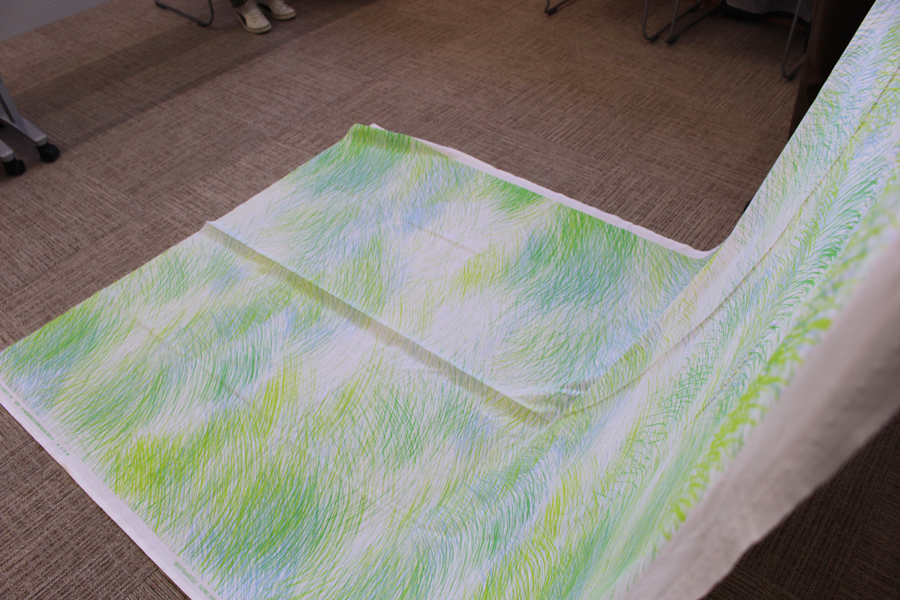
"Lepo (Rest) "(1991)
ー You retired from Marimekko in 2006 and remained with ARABIA for a while before returning to your home country in 2020, what made you decide to return to Japan?
Ishimoto I didn't want to stay in Finland forever, but I thought I would return to Japan at some point. I sold the house in Helsinki where I had been living and returned to Japan in September 2020. I didn't have a concrete idea of what I would do back in Japan, but I knew I wanted to do the pottery I had been doing. But I was thinking about what to do with the studio location and kiln, and in the end it was decided in 2022, two years after I returned to Japan. I decided to set up my studio in Mustakivi, a building with a shop in Dogo, where I ordered the tools I had been using and a kiln the same size as the one I was using in ARABIA. They have a shop and gallery in Mustakivi, where they sell my work and hold solo exhibitions.

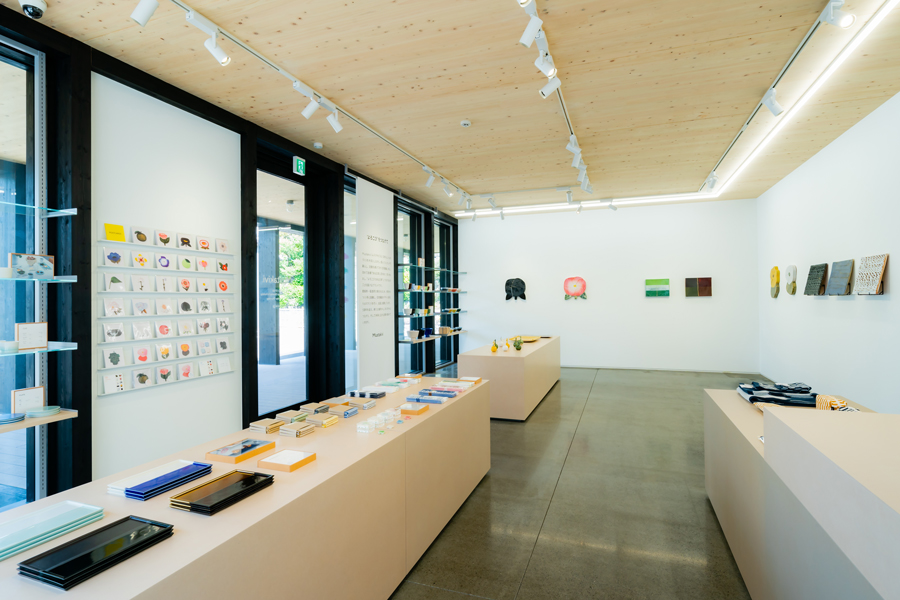
Mustakivi shop & gallery
ー Scandinavian design is very popular in Japan. Our image of Scandinavia is of a unique Scandinavian lifestyle, a commitment to interior design and an affluent way of life. There are also wonderful products made by Scandinavian manufacturers that are close to our daily lives, such as Marimekko textiles, ARABIA tableware and iittala glassware, and I think that the overall combination of these products creates an appeal. You worked for 50 years in Helsinki as a designer and artist for such companies, and I would like to ask you if you have any impressions of the appeal of Finnish design or the soil that gives birth to design in your actual life in the country.
Ishimoto I think it's the people. There are many people in Scandinavia, such as Mr. Kaj Franck, Mr. Oiva Toikka and Mr. Kaipiainen, who create truly wonderful things, and I respected them as creators. I think I was very lucky to be able to meet and talk to them directly. They have passed away, but the things they designed still remain and are used in our daily lives.
An exhibition titled "Finnish Lifestyle: Design for Enriching Lifestyles", which introduces the works of these designers and those of iittala, ARABIA and Artek, has been touring since April this year, starting at the TAKAMATSU ART MUSEUM in Kagawa Prefecture. Most of the items on display there are from Scope, an online interior furniture and goods shop. They also carry a lot of my flower relief works, and I was honoured to have my "Ceramic Flower" work displayed next to a Mr. Kaipiainen flower dish. The exhibition will travel to the Hiroshima Museum of Art in Hiroshima Prefecture and the IIwaki City Art Museum in Fukushima Prefecture next year.
ー Japanese and Scandinavian design have influenced each other for a long time, but from your point of view, have you noticed anything in Scandinavian design that is similar to Japan?
Ishimoto In Finland, about 300 years ago, people ate using plates made of wood instead of ceramics, and wood was a central material in the production of many things. So, I think that's what we have in common with Japan. I myself have never thought about Japanese or Scandinavian styles, and I have never been conscious of it when thinking about design.
Current archive material
ー We would now like to move on to a discussion about the design archive. Are the sketches, drawings and other materials relating to your Marimekko and ARABIA works managed by the respective companies?
Ishimoto In the case of Marimekko, I did not give them the idea sketches. They made a film from my idea sketches and I think Marimekko has all the film and colour scheme records. As far as I remember, Marimekko doesn't have any kind of museum or archive. I don't know about ARABIA.
There is a Design Museum Arabia in Helsinki, Finland, which mainly holds ARABIA ceramics and iittala glass, and some of my works are in there. The Designmuseo in Helsinki also has my Marimekko textiles and my works from ARABIA, but I don't know if they are properly organised in their archives. M+ in Hong Kong also has some of my work.
ー Do you have your own prototypes (sample products) before they are commercialised, or do you donate them somewhere else?
Ishimoto I have them myself. Some of the prototypes I made in the past I have commercialised in my current studio, and some I am thinking of commercialising in the future. For example, there was a vase I designed in ARABIA, but it was not commercialised at the time because there seemed to be some difficulties with the manufacturing process. We were able to commercialise a vase called "PLEATS" this year because Japanese technology was able to do it. It was made by folding a sheet of paper in a mountain and valley pattern, and I took a mould from a prototype I brought back to Japan and reproduced it in Aritayaki.
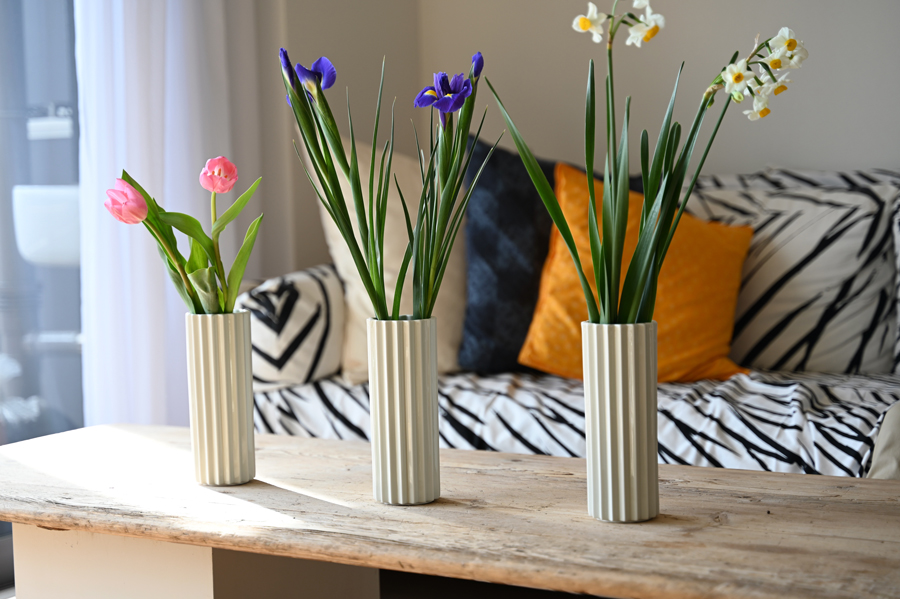
"PLEATS" (2023) Mustakivi
ー Do you keep your idea sketches and memos in an organised way?
Ishimoto That's my biggest weakness. I have them somewhere, if I look for them. Some things are thrown away, of course, though. In 2013, when my first solo exhibition "Playing with Cloth, Playing with Soil" was held at the Museum of Art, EHIME in my hometown, I donated some of my idea sketches along with Marimekko textiles and pottery works.
I drew a lot of idea sketches when I joined Marimekko around 1974. Even looking at it now, I think it's quite nice, and I have commercialised the design drawings into tenugui and other products. They are made using a technique called chusen, which I like. When you pile up layers of tenugui and pour colour from the top, it soaks through to the bottom, so there are no two sides of the same coin. I think it is a wonderful Japanese technique. The tenugui was made by KAMAWANU and is available at Sogo & Seibu, BEAMS and on the Mustakivi website.
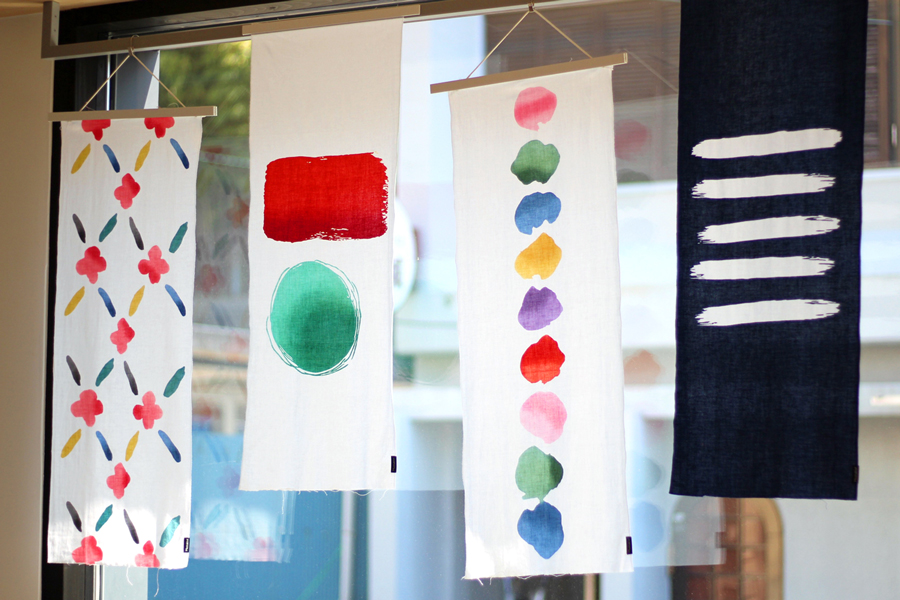
"Tenugui", "SONO", "ISHI", "HANAMICHI", "GOSYUNEN"
ー Do you want your work, sketches and documents to be left behind for future generations so that they can view them at any time and use them as learning and research material?
Ishimoto No, I never organise my sketches and materials, and I never turn them over this way and that. This is the weakest part of me. Organising archive material is a tough job.
ー Do you have any staff or apprentices who can help you organise the archive materials?
Ishimoto No, I think it is better for people to make their own work rather than to become my apprentice. I am not very good at teaching. I have never taught at university before, and I have given a lecture or two at Aalto University in Helsinki, but I took a lot of Marimekko textiles and just spread them out and showed them.
ー I believe that books and collections of works are in a sense archives, passing on a person's thoughts and works to future generations. You have produced a collection of your works, haven't you?
Ishimoto Yes, thanks to you. There are two books: "Fujiwo Ishimoto: Matkalla Resan On the Road", which was made by Marimekko, and "Ishimoto Fujiwo no nuno to tou", which was interviewed and written by design journalist Ms. Noriko Kawakami. I edited the one I made for Marimekko myself, in which you can see some of my photographs of stones. I won the Kaj Franck Design Prize in 1994, and this is a photo of a poster I made for my solo exhibition in Helsinki. The top is a stone from the ISE JINGU in Japan and the bottom is a stone that was lying in front of a church in Lapland, in the far north of Finland. I took the photos myself and they happened to be on the same film.
ー The poster expresses in stone "the person I would have become if I had stayed in Japan and the person I am by staying in Finland" (extract from "Ishimoto Fujiwo no nuno to tou", p.99, PIE International, 2012), doesn't it?
Ishimoto Yes, I went to ISE JINGU a few weeks ago to see if the stones were still there. I was shocked to find that the stone had become very tired. It looked old. I took this photo with my mobile phone at the time, can you see it? I made this poster in 1994, but I photographed the stones in the 1980s, so it's been more than 40 years, but I didn't realise how much they had changed. The stone is certainly the same, though, with the same little cuts and so on. But I thought the stone was standing in front of the woods on the left side of the approach, but when I looked at it this time, I found it by the chozuya(holy fountain), so my memory of the location is different. I think I may have created a beautiful memory on my own. I would like to go and see the stones in Lapland next time.
ー It certainly doesn't have the edge it used to have, and it looks half-full and floppy. Has it been weathered? It would be interesting to contrast the current appearance of the stone and take another photograph.
Revival of old designs
ー Marimekko has revived some of your previous textile designs, hasn't it?
Ishimoto Yes, for example, I revived textiles I designed when I first joined Marimekko, such as "onni (happiness) " with a floral motif, "Kukkaketo (flower garden) " with a four-petalled flower design, "Kuiskaus (whispers) " printed using two line drawing plates, and "Ostjakki (Hanti people) ", inspired by Ehime Prefecture's Iyo-kasuri, which incorporates a blurring technique. They have revived these textiles and developed various products such as cushions, blankets and dresses.
The "Taiga(Meadow)" textile I mentioned earlier was expanded to create a textile called "Suuri Taiga (Prairie) ", which is used for the seat surfaces of furniture at the CHAHARU accommodation facility in Dogo Onsen in Matsuyama, which reopened in 2018. I produced the executive floor rooms on the 9th floor, and my textiles are also used in the furniture and bedding on the other floors, and there is a fabric board on the dining room wall.
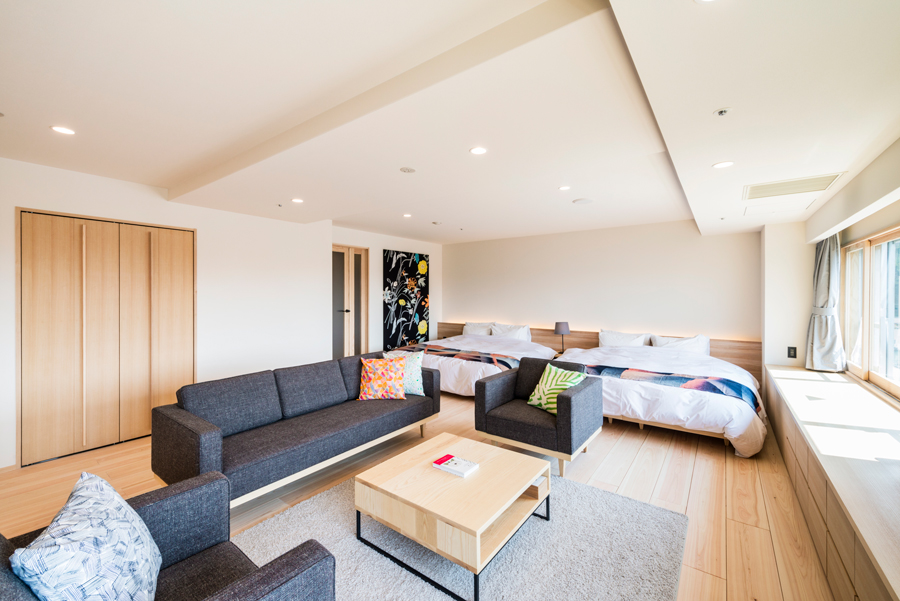
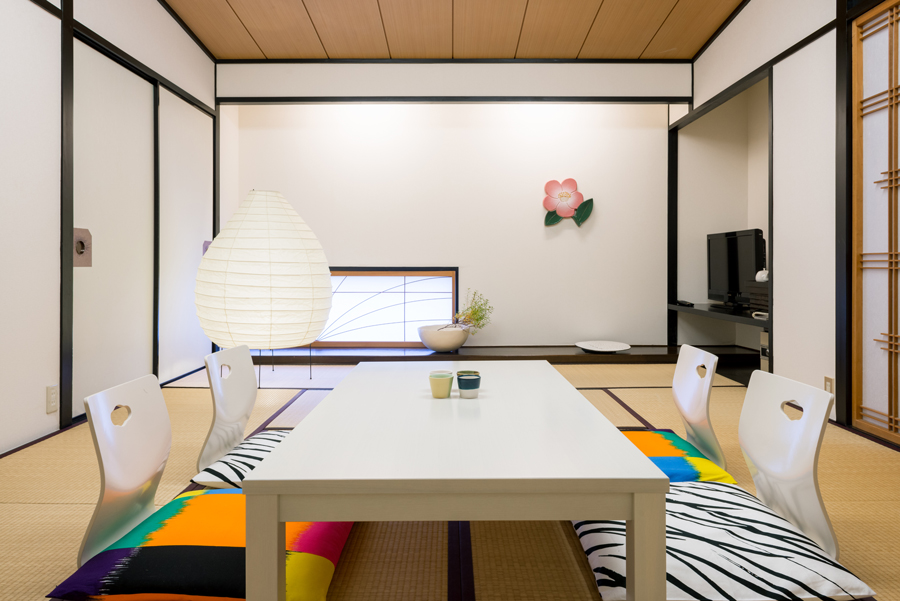
CHAHARU, executive floor rooms, 9th floor
Photo courtesy of CHAHARU Co.,Ltd.
ー I would like to visit next time. You mentioned that Marimekko still has the film, so when they talk about how this would be good to revive at a certain time, they have a system in place in the company where they can reproduce it with the artist's permission. That's wonderful.
Ishimoto Actually, I just received a call from Marimekko. One was about reviving an old textile and the other was about designing a new textile. I hadn't responded to them for a long time, so they finally called me. But to design a new one is impossible. There is a big difference between designing for a small, predetermined shape, such as a tenugui, and designing freely within the 150 cm width of a Marimekko. And I don't have the energy I had then that I have now. Back then, I had a kind of inspiration to do this next thing. When you keep doing that kind of work, it comes to you one after another. But I've been out of that kind of work for a long time, about 20 years. It takes a lot of energy to get an idea. It's very hard work.
ー When creating Marimekko fabrics, it still takes a lot of energy to create a new design. Regarding your pottery work, do you have any current ideas of what you would like to create?
Ishimoto Yes, there are things I want to do with pottery. I don't know if I can do it, but I want to make this plant with a thin stem that grows quickly and then spreads into a large leaf. I think this is probably a fuki, but I think it is different from the Japanese fuki. I don't know if I can do it, but I want to do it. Before I went back home, I took this photo in Finland in 2019.

Photo of plants taken by Ishimoto in Finland.
Photo by Fujiwo Ishimoto
Ishimoto I also drew this on the KESANTO (fallow land) textile that I designed for Marimekko, which is the big leaf in this picture. I made it in relief, but I wanted to make something that could be used as a stand. But it's difficult to make something like this with pottery because of the gravity and the balance. I'm trying to make something like this out of clay. I haven't yet worked out how to achieve this balance. This is a prototype I made before I left Finland, with a stem and flower on top of a mandarin orange, which I think I can make.
ー In your pottery, you often work with fruits as well as flowers and plants. In terms of vegetables, you have also used Tougan(Winter melon) as a subject in your work.
Ishimoto I could put a flower on a "Tougan(Winter melon) ", that's not bad.
ー By the way, do you still have friendships with your classmates from the Tokyo University of the Arts? I heard that Ms. Motoko Ishii's generation holds a reunion every year, and that one of her classmates is Mr. Makio Hasuike. How about Mr. Ishimoto's generation?
Ishimoto The members of the crafts department in my generation also have a class reunion every year. It has been about 60 years since we graduated. I think Mr. Kawakami and Mr. Matsunaga also participate from time to time. I was in Finland, so it was difficult for me to participate in the meetings in Japan, but I did participate once when the meeting was held on Shodoshima. One of my classmates used to live in Italy, and I was in Helsinki at the time, so we all invited our families and about 20 of us got together and went around Helsinki, Stockholm and Copenhagen together.
ー You make ceramics, Mr. Kawakami uses lacquer for furniture and Mr. Matsunaga makes bronze sculptures. I wonder if it is because everyone was exposed to crafts at the Tokyo University of the Arts, or if that experience is still alive today.
Ishimoto That may be so. When I first studied pottery at the Tokyo University of the Arts, I thought it was really interesting, and it was also interesting to learn many things in ARABIA. I'm in my 80s and I'm still working with clay, and I come to the studio every day now.
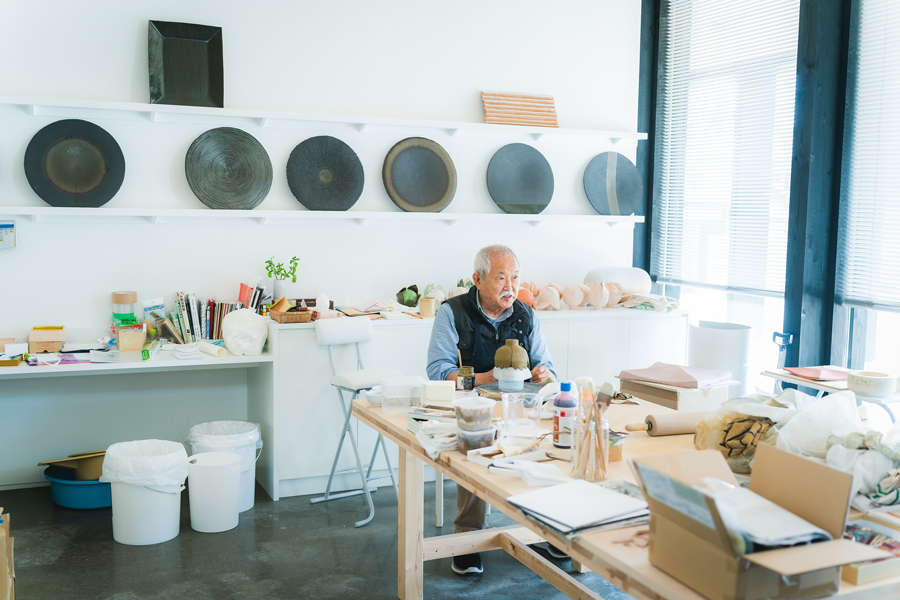
Mr. Ishimoto's atelier
Ishimoto I would like to visit next time I am in the area. I hope you will continue to create many wonderful works of art and make our lives more exciting. Thank you very much for your time today.
Enquiry:
Mustakivi https://mustakivi.jp

